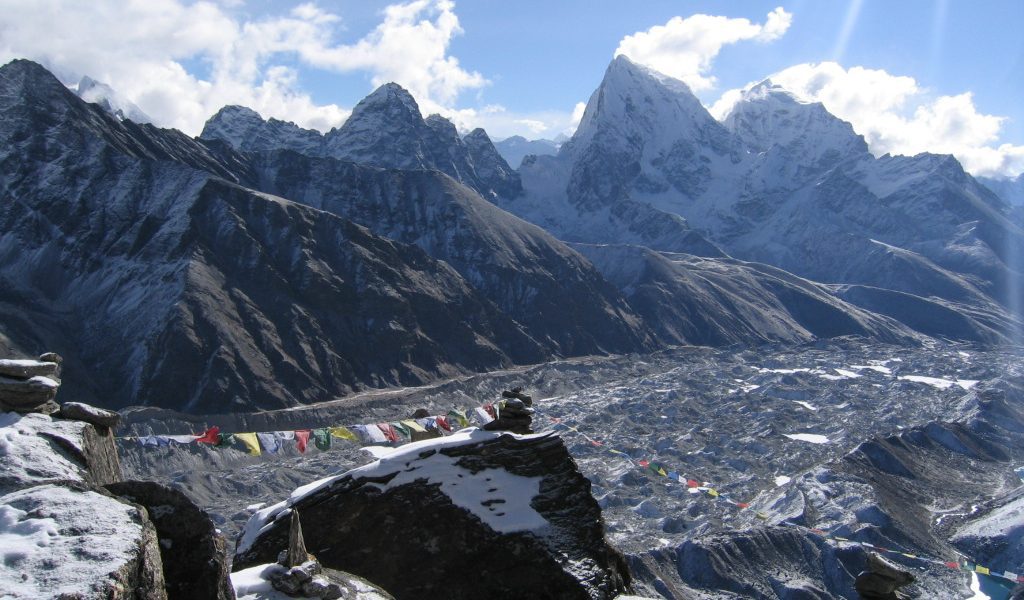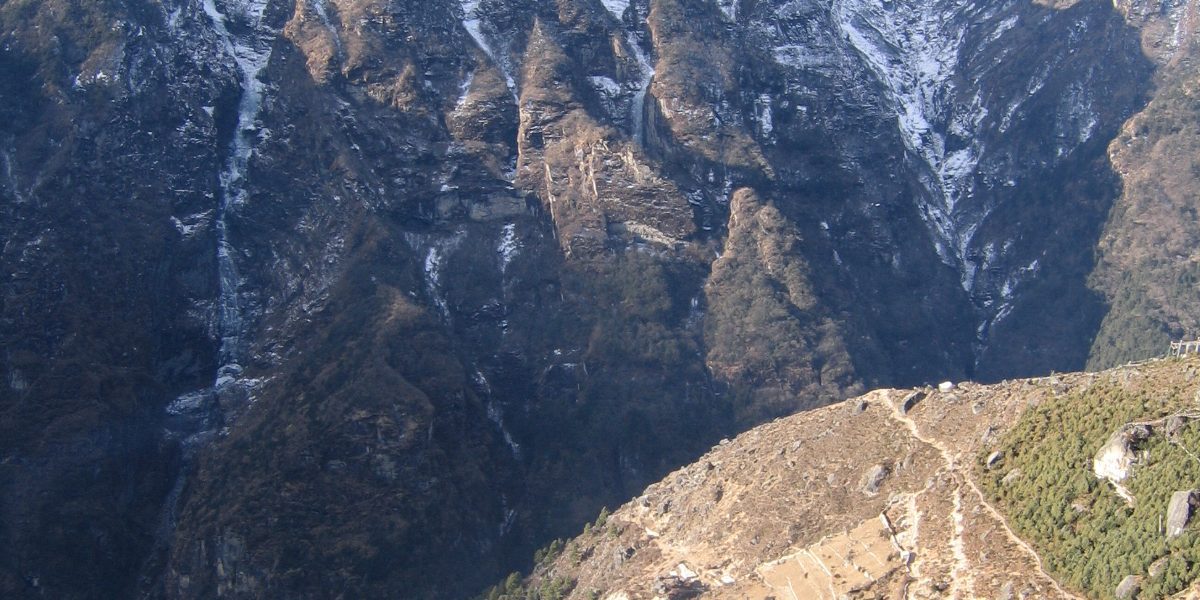Location
Everest Base Camp

5.0
Among the many trekking options in Nepal, Everest via Gokyo Lakes is truly special. It offers stunning views of the highest peaks and a chance to explore beautiful, remote villages. If you want a trek that combines incredible scenery with a real taste of local culture, the Gokyo route is the perfect choice.
Everest Base Camp
14 Days
Trekking
Lodges
All included except in Kathmandu
Min. 2 Pax
Spring and Autumn
5350m.
The Everest region, renowned for its towering peaks, offers trekkers some of the most stunning vistas of 8,000-meter and 7,000-meter mountains in the world. This less-traveled path provides a unique opportunity to experience not only dramatic landscapes but also the essence of local Sherpa culture. As you trek, you’ll encounter icy rivers, rocky glacier debris, and the mesmerizing turquoise waters of the Gokyo Lakes. You can enjoy fewer crowds compared to more popular routes.
The journey begins from Kathmandu to Ramechhap via bus and then a flight to Lukla, quickly gaining altitude and placing trekkers at the foot of the towering peaks. From Lukla, the trail leads to Namche Bazaar, the vibrant and bustling capital of the Sherpa region. Namche is a small town with modern conveniences such as internet, stores, and a variety of dining options. It offers a blend of contemporary amenities and traditional Sherpa hospitality.
As you continue along the trail, the path gradually ascends toward the Gokyo Lakes. Along the way, you’ll have the chance to explore ancient Buddhist monasteries, which provide a glimpse into the rich cultural and spiritual life of the Sherpa community. One of the trek’s major highlights is the climb to Gokyo Peak. This ascent rewards you with panoramic views of Everest and its neighboring peaks. The journey then returns you to Lukla.
It’s important to note that during the Spring and Autumn seasons, flights to Lukla may be rerouted through Ramechhap due to weather conditions. This may add an extra day to your trek. However, this adjustment provides an additional opportunity to enjoy the beauty and diversity of the region before completing your adventure.
We begin our journey with a transfer from Kathmandu to Ramechhap. You can choose between a local bus or a private vehicle for the journey. Along the way, you’ll pass through picturesque landscapes, giving you a glimpse of the natural beauty that Nepal has to offer. Upon arrival in Ramechhap, you’ll stay in a cozy lodge for the night.
We will take an early flight from Ramechhap to Lukla marking the start of our trek. In Lukla, you’ll meet your porter team, who will assist you throughout your journey. The trek begins with a walk through Sherpa country, where you’ll meet the first Buddhist monasteries in Chuplung. The trail follows the Dudh Koshi River, passing barley and wheat fields. After about four hours of trekking, you’ll reach Phakding. You’ll spend the night in a mountain hotel.
Trekking: 4 hours
Elevation: ↑ 50m, ↓ 240m
Today’s trek takes you along the Dudh Kosi to Jorsale (2800m). You’ll cross the river on a suspension bridge and then begin a rapid ascent of 600 meters to Namche Bazaar. This bustling Sherpa town is a hub of activity with numerous shops, a post office, and a bank. You can visit a small monastery and explore the market, which offers Tibetan and Chinese products brought over the Nang Pa La pass by yak. You’ll spend the night in a comfortable lodge.
Trekking: 6 hours
Elevation: ↑ 930m, ↓ 100m
Today is an acclimatization day, which is necessary for adjusting to the higher altitudes. You’ll make a steep ascent to the beautiful village of Khumjung, which is twinned with Khunde. You’ll stay in a rustic lodge that offers the best views of high peaks such as Mount Everest, Nuptse, Lhotse, Ama Dablam, and Thamserkhu. Take a walk around the large Sherpa town, where Sir Edmund Hillary established a school and a hospital, contributing significantly to the local community.
Trekking: 1.5 hours
Elevation: ↑ 320m
The route takes you along the slopes of Khumbila, a mountain revered by the Sherpas. You’ll pass through the village of Mong before descending in switchbacks to the Dudh Khosi River and finally reach Phortse Tenga. You’ll spend the night in a lodge.
Trekking: 4 hours
Elevation: ↑ 135m, ↓ 220m
Your trek continues with an ascent through forests of rhododendrons and pines, passing summer yak herder camps. The trail becomes steeper as you approach Dole, but the scenery keeps you motivated. After about four hours of trekking, you’ll reach Luza, where you’ll stay overnight.
Trekking: 4 hours
Elevation: ↑ 765m, ↓ 50m
Today, the journey takes you along the river to the beautiful small village of Machhermo. From there, the trail climbs a ridge and descends along the moraine of the Ngozuma Glacier. A steep climb brings you to the first Gokyo Lake, and the trail flattens out as you continue to the second and third lakes. The views are spectacular, and you’ll spend the night in Gokyo.
Trekking: 4 hours
Elevation: ↑ 472m, ↓ 112m
Today, we will hike up to Gokyo Ri (5350m) for breathtaking views of Cho Oyu, Lhotse, Nuptse, Makalu, and Everest. After enjoying the stunning panoramas, you’ll descend to the village of Na. The descent offers a different perspective of the landscape and is equally enjoyable.
Trekking: 5.5 hours
Elevation: ↑ 600m, ↓ 910m
We will retrace our steps back to Phortse Tenga. This village is off the main trekking circuit and therefore represents a more authentic Sherpa village. After trekking for about four hours, we will arrive at Phortse Tenga, where we will spend the night.
Trekking: 4 hours
Elevation: ↓ 765m
Today, we follow the Imja Khola on a relatively short and gentle trek to Pangboche. The Imja Khola is a tributary of the Dudh Kosi in Nepal, draining the slopes of Mount Everest. We will spend the night in Pangboche.
Trekking: 3 hours
Elevation: ↑ 150m, ↓ 35m
After crossing the Imja Khola, we will descend and then ascend to reach Tengboche. This village is home to the most renowned monastery in the Khumbu region. The views of Ama Dablam from here are truly magnificent. You’ll be staying overnight in Tengboche.
Trekking: 4 hours
Elevation: ↑ 150m, ↓ 150m
We will descend to Namche Bazaar, passing through Khumjung once again. The trail offers a mixture of descents and ascents, making for an engaging trek. You will spend the night in Namche.
Trekking: 6 hours
Elevation: ↑ 260m, ↓ 680m
Your trek follows the Dudh Koshi River, descending to Ghat (2500m) before a final ascent to Lukla. It will be a long day of trekking, but the beautiful scenery and the sense of accomplishment will make it worthwhile. You will spend your last night in Lukla.
Trekking: 7 hours
Elevation: ↑ 300m, ↓ 940m
Our adventure will come to an end with a flight from Lukla to Ramechhap, followed by a four-hour drive back to Kathmandu. While returning to the bustling city, you can reflect on your incredible journey and carry unforgettable memories of the Himalayas with you.
Glacier Safari Trek offers customization options to improve your trekking experience. Choose our Eco category for a more minimalist approach, where you trek without a porter, allowing for a more self-sufficient adventure. Alternatively, opt for our Grand Comfort category, which provides upgraded accommodation and additional comforts. We provide a more luxurious and relaxing trek. For more details or to book your preferred category, please contact us.
Starting from
Instant Booking
Secure Payments
No Hidden Costs
Easy


5.0
Tripadvisor Traveler Rating
Recent Traveler Reviews
No upcoming trip dates available at this time.






